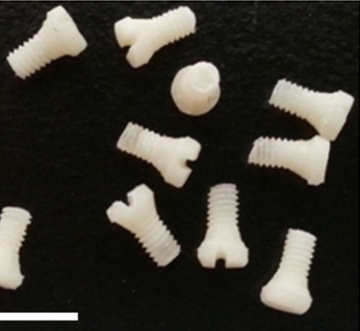When a person suffers a broken bone, treatment may call for the surgeon to insert screws and plates to help bond the broken sections and enable the fracture to heal. These “fixation devices” are usually made of metal alloys.
These metal devices have disadvantages: Because they are stiff and unyielding, they can cause stress to underlying bone. They also pose an increased risk of infection and poor wound healing. In some cases, the metal implants must be removed following fracture healing, necessitating a second surgery. Resorbable fixation devices, made of synthetic polymers, avoid some of these problems but may pose a risk of inflammatory reactions and are difficult to implant.

Now, using pure silk protein derived from silkworm cocoons, a team of investigators from Harvard Medical School, Beth Israel Deaconess Medical Center and Tufts University School of Engineering has developed surgical plates and screws that may offer improved bone remodeling following injury. Equally important, the devices can also be absorbed by the body over time, eliminating the need for surgical removal.
The findings, demonstrated in vitro and in a rodent model, are described in the March 4 issue of Nature Communications.
“Unlike metal, the composition of silk protein may be similar to bone composition,” said co-senior author Samuel Lin, HMS associate professor of surgery in the Division of Plastic and Reconstructive Surgery at Beth Israel Deaconess. “Silk materials are extremely robust. They maintain structural stability under very high temperatures and withstand other extreme conditions, and they can be readily sterilized.”
Lin worked with co-senior author and Tufts chair of biomedical engineering David Kaplan. “One of the other big advantages of silk is that it can stabilize and deliver bioactive components, so that plates and screws made of silk could actually deliver antibiotics to prevent infection, pharmaceuticals to enhance bone regrowth and other therapeutics to support healing,” said Kaplan.
First author Gabriel Perrone, of the Department of Biomedical Engineering at Tufts, used silk protein obtained from Bombyx mori silkworm cocoons to form the surgical plates and screws. Produced from the glands of the silkworm, the silk protein is folded in complex ways that give it unique properties of both exceptional strength and versatility.
To test the new devices, the investigators implanted a total of 28 silk-based screws in six laboratory rats. Insertion of screws was straightforward and assessments were then conducted at four weeks and eight weeks, post-implantation.
“No screws failed during implantation,” said Perrone, explaining that because silk is slow to swell, the new devices maintained their mechanical integrity even when coming into contact with fluids and surrounding tissue during surgery. The outcomes suggest that the use of silk plates and screws can spare patients the complications that can develop when metal or synthetic polymer devices come into contact with fluids.
“Having a resorbable, long-lasting plate and screw system has potentially huge applications,” said Lin. While the initial aim is to use silk-based screws to treat facial injuries, which occur at a rate of several hundred thousand each year, the devices have potential for the treatment of a variety of different types of bone fractures.
“Because the silk screws are inherently radiolucent (not seen on X-ray) it may be easier for the surgeon to see how the fracture is progressing during the post-op period, without the impediment of metal devices,” added Lin. “And having an effective system in which screws and plates ‘melt away’ once the fracture is healed may be of enormous benefit. We’re extremely excited to continue this work in larger animal models and ultimately in human clinical trials.”
This research was supported by the National Institutes of Health (EB002520).
Adapted from a Beth Israel Deaconess news release.


